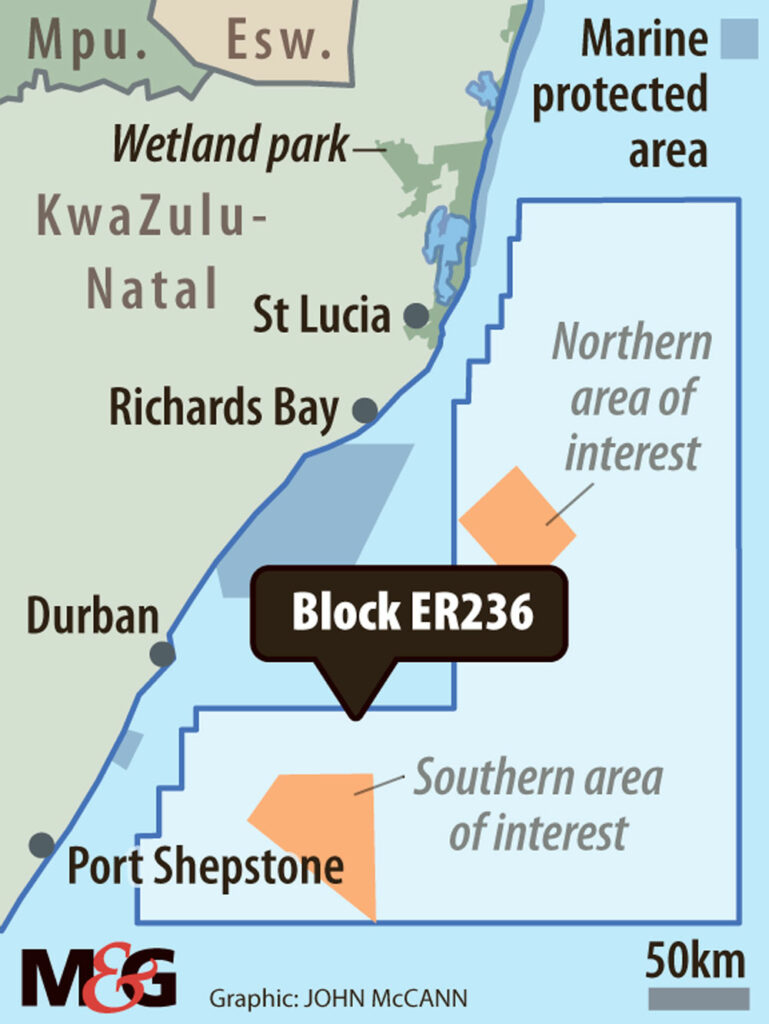Vulnerable: Environmentalists argue that the proposed oil and gas exploration and production will disrupt people’s livelihoods and the marine life following the huge shoals of sardines. (Rajesh Jantilal/AFP)
The South Durban Community Environmental Alliance (SDCEA) has hauled Barbara Creecy, the minister of forestry, fisheries and the environment, to court over her decision to authorise oil and gas exploration off the KwaZulu-Natal coast.
The SDCEA filed an extensive review application in the Pretoria high court last month, challenging the green light Creecy has given to Eni South Africa and Sasol for their planned venture in offshore block ER236, which is off the KwaZulu-Natal coast between East London and St Lucia.
The alliance, represented by environmental law specialists Cullinan & Associates, is being supported by Natural Justice and the nonprofit, Green Connection.
The organisations say the review application is “undoubtedly a watershed” case, because it “stands to influence how, and whether if at all”, deep sea exploration and production in South Africa will be conducted.
Should the project go ahead, it will result in the drilling of up to six exploration and appraisal wells in block ER236.
In October 2019, the SDCEA appealed authorisation for the project, but this was rejected by Creecy in December last year, together with the appeals of 46 others.
In its court papers, the SDCEA details how the potential drilling sites are located close to several marine protected areas), critical biodiversity zones and ecologically and biologically significant areas.
Several reports it has commissioned highlight deficiencies in the final environmental impact assessment report, including the failure to properly assess the effects on marine protected areas, critical biodiversity sites and ecologically and biologically significant zones.
In her report, marine scientist Jean Harris, the executive director of Wildoceans, notes how four of these marine protected areas — Protea Banks, uThukela, Pondoland and Aliwal Shoal — “are close enough to the to the proposed drilling sites, and their location relative to sites is such as, to make them vulnerable to persistent degradation and damage from day-to-day operational oil leakages and smaller spills that are well documented to occur, in addition to them being at significant risk should a major oil spill incident happen”.
Living organisms in the area include humpback whales that migrate up the east coast from their feeding grounds in Antarctica, offshore and coastal dolphins, sharks, rays and seabirds, as well as turtles that use the Agulhas current as transport highways and the offshore eddies as productive feeding areas.
Sardines that move up the east coast and attract top predators such as sharks, seabirds, and dolphins, could also be affected.
The drilling sites were being pursued “in an area of extremely dynamic coastal processes”, where wind, swell and currents collide. This increased the risk of damage to the installations and consequently the risk of a major oil spill, she said, which would “cause long-lasting adverse effects for both people in coastal communities as well as to the non-human organisms that are part of the whole community”.
These areas will also bear the effect of “other associated activities such as seismic surveys and increased shipping activities”.
In another report, Simon Elwen, a marine ecologist and research associate in the department of zoology and biology at Stellenbosch University, noted how the planned hydrocarbon extraction “will lay the foundation for further expansion of fossil fuel infrastructure in both marine and terrestrial ecosystems”.
He said marine protected areas remain vulnerable to effects well outside their boundaries because of the “fluid and interconnected nature of the ocean and most life within it. These boundaries are completely pervious to noise, chemical spills, water degradation and solid pollution, which may move in or out of these areas with currents and tides.
“Thus, activities hundreds and even thousands of kilometres away can affect the overall habitat quality within these areas.”
He said the interconnected nature of the oceans and the vulnerabilities of spatial planning is “most evident in the massive areas potentially affected by oil in the case of a blowout”.
 (John McCann/M&G)
(John McCann/M&G)In her report, Michelle Fournet, a postdoctoral research associate at Cornell University’s K Lisa Yang Centre for Conservation Bioacoustics, said the final report failed to adequately model or measure sound propagation in this region.
“This is particularly pertinent, for example, in the Protea Banks and Sardine Route, the first of which contains a cold-water coral system and the second of which is a major fish migration corridor. Larval corals rely on reef sounds to determine where to settle; disturbance to reefs and associated soundscapes negatively impacts coral settlement, and thus continued reef building.”
She said turtles and whales, important to the iSimangaliso Wetland Park area, migrate through the ocean in ways that could be affected by the proposed activity but this was not assessed in the final report.
Desmond D’Sa, the coordinator of the SDCEA, said in his founding affidavit that the authorisation of new oil and gas activities runs contrary to South Africa’s climate change commitments, including its commitment to the Paris Climate Agreement.
“The exploratory activities are intended to lead to future production of oil and/or gas, which would serve to exacerbate fossil fuel dependency, and increase South Africa’s vulnerability to climate change impacts due to increased greenhouse gas emissions, with devastating adverse climate change impacts.”
Creecy’s department said it has filed a notice to oppose the review application. “The department cannot comment on the merits of the application at this stage as it is currently compiling the record of decision,” it said.Sasol and Eni previously told the Mail & Guardian that they both upheld the same stringent standards of safety, compliance and environmental management.